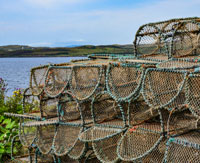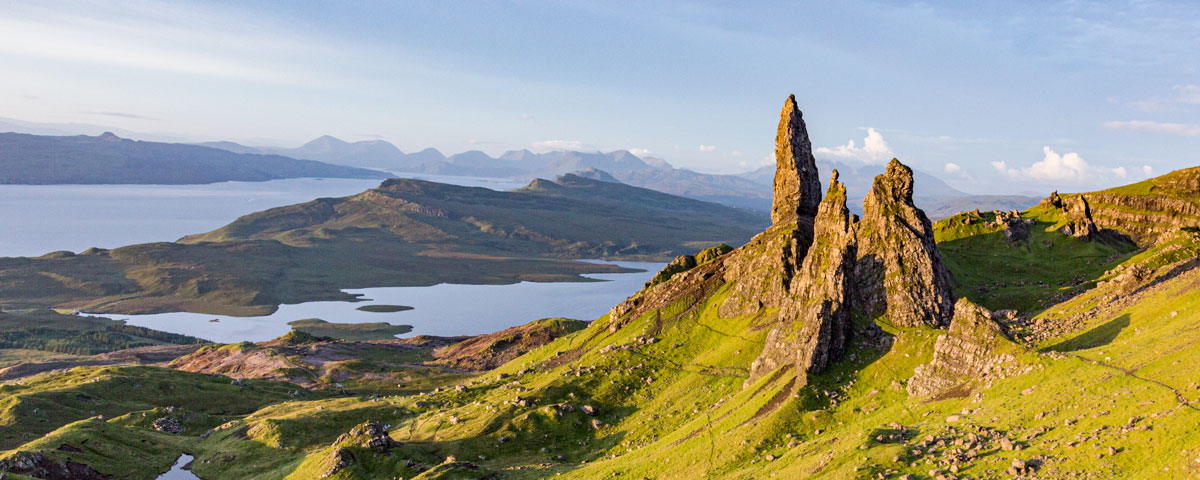
There is nowhere on Skye that is more than five miles from the sea and, since early man, people have harvested the produce of salt and fresh water on the Island’s shores and banks to sustain a modest living.
For millennia, fishing has been one of Skye’s main industries and today remains an important economic sector next to tourism, agriculture and forestry.
Evidence of an early maritime economy centred around the harvesting of fish and shellfish is scattered about Skye’s coastline in the form archaeological deposits in caves, rock shelters and middens and indicates the importance of the industry to communities as far back as the early Iron Age.
Fishing sustained the poor crofters after the first of the Highland Clearances forcibly moved them from the richer areas of soil to the barren fringes of coastline. With poor earth and stony ground making cultivation difficult and often impossible, crofters sought sustenance from fish, shellfish, sea birds and marine mammals to feed their starving families.
Marine fishing was undertaken in small open boats from which small nets would be used to haul in the day’s catch. Bivalves would be collected from the shore and a number of river traps would be utilised on salmon on their way to their inland spawning grounds.
In 1790, in a bid to improve the lives of impoverished families removed from their homes during the Clearances, the British Fisheries Society engaged famous Scottish civil engineer Thomas Telford to design a fishing port on Loch Bay at Stein. The plans, however, never came to fruition and the project was abandoned. Some of the buildings, however, including the pier, smithy and storehouse, still stand today.
Until WWI, herring provided the mainstay of Skye’s fishing industry and, during the years of the herring boom between the late 19th century and early 1900s, fishing stations were set up around the coastline where the catch would be gutted, salted and packed for shipment to the mainland by paid workers, normally female. Examples of such stations could be found on shores of Loch Na Daal, Isleornsay; and a small station near Ard Dorch on Loch na Cairidh.
There is also a herring trail at Am Ploc (The Plock of Kyle), close to the Skye Road Bridge, which was a path used to transport the fish by land from Bàgh Iasgairean, or Fisherman’s Bay, on the north east side of The Plock to the pier in Kyle.
Although industrial scale fishing provided employment for crew, gutters and curers, overfishing, war in Europe and a number of natural and economic factors, gradually led to its decline. A complete ban on herring fishing in any form of herring was imposed in 1977 and lifted in 1983.
The wild Atlantic salmon suffered a similar fate. Native salmon were once plentiful in and around Skye, providing food and jobs for the local communities. There were salmon netting stations at Camustianavaig, Lealt, Portree, Rigg and Staffin. The fish would be caught in nets, dried and then sent to the ice house in Portree where they were then shipped to the mainland. With the advent of commercial netting practices, overfishing, predation, habitat loss and aquaculture, native salmon stocks have declined to such an extent that anglers may only now fish for salmon on the fly, under permit and on a catch and release basis.
The coming of the fish farm has divided local communities. Today Skye has over 20 fish farms in its sheltered inshore waters and, although the industry provides employment for members of the rural communities, this form of aquaculture has been strongly linked to a degradation of water health, the negative impact of native species, disease in farmed fish as well as the destruction of marine ecosystems.
Today Skye is renowned for the exceptional quality of its fish and seafood. Prawn and langoustine fishermen set out every day, weather permitting, for this luxury natural harvest which is exported to restaurants and speciality retail businesses across the globe. Creels bring in lobster and crab while the Island’s oysters, mussels and hand-dived scallops grace the tables of the world. Skye is also home to a seaweed industry and sea salt farm.
Angling
For the sea fisherman, Skye, with its deep blue waters and stunning scenery, is a bucket-list destination. The herring run from the beginning of June and there are ling, pollack, mackerel, coalfish, tope, wrasse, dogfish and flatfish, as well as the very occasional cod, caught from the rocky coastline year-round. Some of the best shore fishing spots are Neist Point and the jetties at Elgol, Carbost and An Corran near Staffin.
There are a number of charter boats for hire from the main harbours and guided trips for those who wish to make a day of it on the open sea. Many accommodation providers have a stash of fishing tackle to borrow for those who are willing to try their hand at catching a big fish.
For the fresh water angler, the main fishing season for salmon takes place between July and October and The Flats of the River Snizort are said to give the keen angler the best opportunity to catch these wild fish. The Snizort and Loch Sligachan are also good for brown trout and the rare sea trout from June to September.
River fishing requires a permit which can be obtained by the respective angling associations, local ghillies or estate bailiffs. Fly fishing is not permitted on a Sunday.

